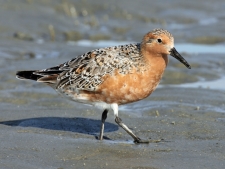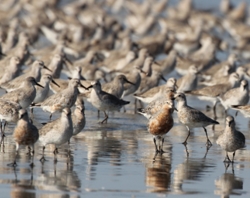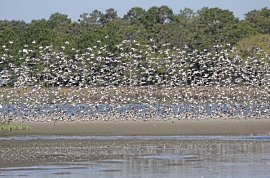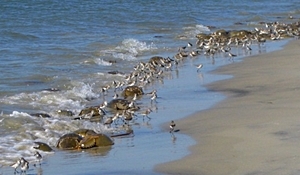Wildlife - Species

Status in SC: Highest Priority, Federally Endangered
Red Knot
Overall, the number of Red Knots has declined nearly 85% over the last 15 years from an estimated population of over 150,000 to the current number of approximately 25,000 (Niles et al. 2008, Dey and Niles 2011). Because of this drastic population decline, the Red Knot has been listed as "Federally Threatened" under the Endangered Species Act.



Red Knot (Calidris canutus)
Description
The red knot, a member of the family Scolopacidae, is a short legged, robin-sized shorebird. Scolopacids include familiar coastal birds such as sandpipers, the smallest of which also belong to the genus Calidris. During the breeding season, red knots exhibit black, brown and chestnut colored plumage above and a pinkish-cinnamon breast and face. In winter, the plumage changes to pale gray above and white below. Its legs are a greenish color, and the bill is slightly tapered and black. Red knots are not sexually dimorphic; both males and females look the same.
Preferred Habitat and Biology
Red knots winter in the coastal United States from Cape Cod to Mexico and South America and spend the summer on islands in the High Arctic. They over-winter all along the South Carolina coast, primarily on sandy beaches and mud flats.
Red knots raise only one brood per year. Nests are constructed near water on shallow depressions lined with leaves and lichens. Both adults incubate 3-4 olive-buff eggs for about 3 weeks. Young red knots fledge 18-20 days after hatching. This species feeds on mollusks, marine worms, and horseshoe crab eggs. During migration, knots gather in huge flocks, stopping along coastal areas to recharge their energy reserves for their flight to wintering grounds in Central and South America. Near Delaware Bay, their migration stopover coincides with the horseshoe crab's annual spawning. The abundance of horseshoe crab eggs provides ample protein for the migrating knots. In recent times, however, habitat alteration and human activities have threatened populations of horseshoe crabs thus indirectly putting migrating birds such as the red knot, at risk.
Species Significance
SCDNR has conducted research on Red Knots including capturing and banding birds with uniquely engraved markers, surveying migrating and wintering flocks, resighting banded birds, identifying forage items, and fitting birds with geolocator devices. Geolocators are small, electronic devices that measure and record light levels to determine global location. Geolocators have been used to study bird migration routes, and identify staging areas and nesting locations.
Despite the large flocks sometimes present on our beaches, shorebirds are declining. Because large numbers of shorebirds often concentrate in a single location at a stop-over site, they are vulnerable to disturbance. Joggers, beach combers, bicyclists, and off leash dogs can flush feeding and roosting birds causing them to expend energy in flight. This may cause them not to build enough fat reserves for their migration journey.
Red Knot flocks roost on inlets of barrier beaches and islands in South Carolina and feed on coquina (Donax sp.) clams in the fall and winter. In the spring, Red Knots and other shorebirds feed on Horseshoe Crab (Limulus polyphemus) eggs when crabs come onshore to spawn. The link between Horseshoe Crabs and shorebirds is an interesting one. Horseshoe Crabs surface to spawn in great numbers every spring, drawn ashore by full and new moons and when tides are highest. The female Horseshoe Crabs lay thousands of eggs in the sand, and shorebirds like the Red Knot spend time on spawning beaches and feed on the crabs' nutrient-rich eggs to fatten up before their migration to the breeding grounds in the Arctic.
References
Bull, J. L. and J. Farrand, Jr. 1995. National Audubon Society Field Guide to North American Birds. Eastern Region. The Audubon Society field guide series. Alfred A. Knopf Inc., New York, NY.
Ehrlich, P. R., D. S. Dobkin, and D. Wheye. 1988. The birder's handbook: A field guide to the natural history of North American birds, including all species that regularly breed north of Mexico. Simon & Schuster, New York, NY.
National Geographic Society. 1987. Field guide to the birds of North America. Second edition. National Geographic Society, Washington, DC.
Niles, L.J., H.P. Sitters, A.D. Dey, P.W. Atkinson, A.J. Baker, K.A. Bennett, R. Carmona, K.E. Clark, N.A. Clark, C. Espoz, P.M. Gonzalez, B.A. Harrington, D. E. Hernandez, D.S. Kalasz, R.G. Lathrop, R.N. Matus, C.D.T. Minton, R.I.G. Morrison, M.K. Peck, W. Pitts, R.A. Robinson, and I.L. Serrano. 2008. Status of the Red Knot (Calidris canutus rufa) in the Western Hemisphere. Studies in Avian Biology No. 36.
Sprunt, A., Jr. and E. B. Chamberlain. 1970. South Carolina bird life. University of South Carolina Press, Columbia, SC.
